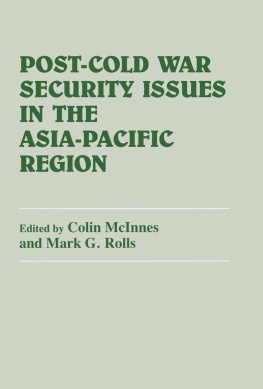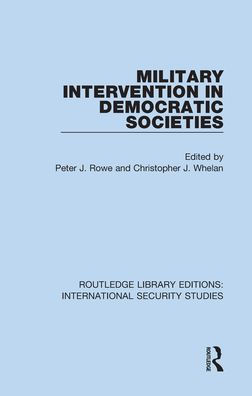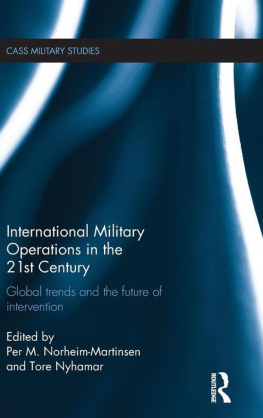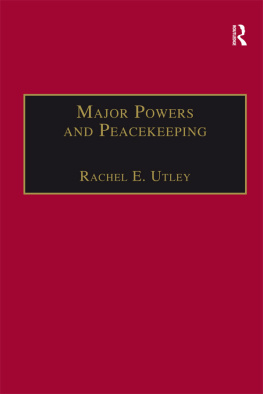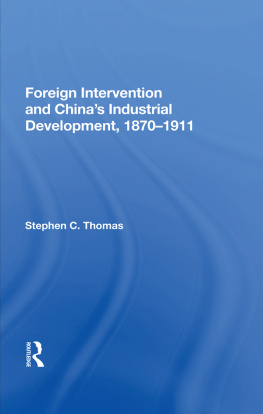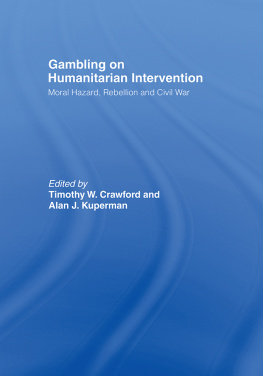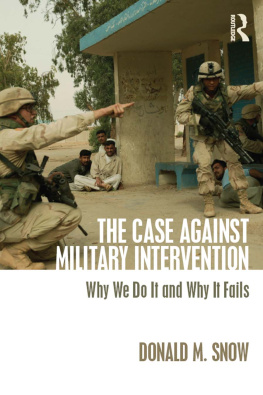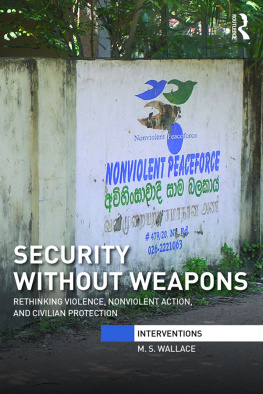DIMENSIONS OF WESTERN MILITARY INTERVENTION
Books of Related Interest
Explaining NATO Enlargement
edited by Robert W. Rauchhaus
Stability and Security in the Baltic Sea Region:
Russian, Nordic and European Aspects
edited by Olaf F. Knudsen
NATO Enters the 21st Century
edited by Ted Galen Carpenter
US National Defense for the TwentyFirst Century:
And the Grand Exit Strategy
by Edward Olsen
International Security in a Global Age:
Securing the TwentyFirst Century
edited by Clive Jones and Caroline KennedyPipe
Dilemmas of International Intervention
edited by Donald A. Sylvan and Michael Keren
DIMENSIONS OF
WESTERN MILITARY
INTERVENTION
Editors
COLIN MCINNES and
NICHOLAS J. WHEELER
University of Wales, Aberystwyth
First published in 2002 in Great Britain by
ROUTLEDGE PUBLISHERS
2 Park Square, Milton Park, Abingdon, Oxon, OX14 4RN
270 Madison Ave, New York NY 10016
Transferred to Digital Printing 2010
Copyright 2002 Routledge
Website: www.routledge.com
British Library Cataloguing in Publication Data
Dimensions of Western military intervention
1. International relations 2. Intervention (International law)
3. Humanitarian intervention 4. Europe Politics and government 1989
5. United States Politics and government 1989
I. McInnes, Colin, 1960 II. Wheeler, Nicholas J.
327.117
ISBN 071465276 8 (cloth)
ISBN 071468248 9 (paper)
Library of Congress Cataloging-in-Publication Data
Dimensions of Western military intervention / editors, Colin McInnes and Nicholas J. Wheeler.
p. cm.
Includes bibliographical references and index.
ISBN 0714652768 (hardback) ISBN 0714682489 (paperback)
1. Intervention (International law) I. McInnes, Colin. II. Wheeler,
Nicholas J. III. Title.
KZ6368 .D56 2002
341.584dc21
2001007716
This group of studies first appeared as a special issue of Contemporary Security Policy,
ISSN 1352-3260, Vol.22, No.3 (December 2001) published by Frank Cass and Co. Ltd.
All rights reserved. No part of this publication may be reproduced, stored in or introduced into a retrieval system, or transmitted, in any form or by any means, electronic, mechanical, photocopying, recording or otherwise, without the prior written permission of the publisher of this book.
Publishers Note
The publisher has gone to great lengths to ensure the quality of this reprint but points out that some imperfections in the original may be apparent.
Contents
| Nicholas J. Wheeler |
| Colin Mclnnes |
| Colin S. Gray |
| Cori E. Dauber |
| Linda Melvern |
| Dominick Donald |
| Paul Williams |
| Trevor Findlay |
| Jayne Rodgers |
Preface
This volume is the product of a series of meetings of the Security Research Group in the Department of International Politics at Aberystwyth. The meetings were held in 1999 and the first half of 2000 under successive convenors of the Group, Colin McInnes and Nicholas J. Wheeler, the editors of this volume. The programme culminated in a day-long seminar in May 2000, funded by the ESRC as part of its Politics of Emergencies series. The editors would like to thank all members of the Security Research Group for their various contributions. In particular they would like to thank Eli Stamnes and Patricia Owens for their help in organizing the seminar, Jenny Edkins as convenor of the ESRC Politics of Emergencies series, and Cliona Saidlear for her editorial assistance.
Introduction: The Political and Moral Limits of Western Military Intervention to Protect Civilians in Danger
NICHOLAS J. WHEELER1
The decade of the 1990s witnessed a fundamental transformation in the demands placed upon the United Nations (UN) capacity to maintain international peace and security. The UN was set up in 1945 to manage inter-state violence on the model of the aggression of the Axis powers. But with the exception of the Chapter VII policing action against North Korea in 1950, and against Iraq in 1991, the UN Security Council has not mobilized its collective security powers under the UN Charter against this form of aggression. It might be argued that it should have done so to reverse Israels illegal occupation of the West Bank and the Gaza Strip, or to evict Indonesia after its illegal annexation of East Timor in 1975. But in these cases, the patronage of the US protected Indonesia, and especially Israel, from any remedial UN action. But if inter-state violence was generally absent from the UN agenda during the Cold War, then the same could not be said of intra-state violence: the era of de-colonization in Africa and Asia ushered into existence newly independent states, many of which lacked any effective claim to political authority. As governments tried through a variety of rewards and punishments to foster a sense of national identity, legitimate political authority was frequently contested through violence. Ethnic and tribal groups resisted centralization and fought for greater autonomy, or even independent statehood. The Security Councils response to such conflicts was to argue that it had no mandate to intervene in the internal affairs of a Member State unless intervention was requested by it, or the parties to an internal armed conflict. Article 2(7) of the Charter served to protect even the most barbaric regime from external intervention. Thus, when thousands of Bengali civilians were slaughtered by Pakistani soldiers in 1971, the Council was united in arguing that whilst deplorable, this was a matter that fell within Pakistans internal affairs.
The UNs position that it would only act if there was consent from the warring parties led it to create a new instrument of conflict management termed peacekeeping. This was a third party military force comprising volunteer soldiers from Member States which would deploy under UN command with the consent of the belligerents. In addition to consent, the key characteristics of traditional peacekeeping were neutrality and the use of force only in self-defence. There was no question of UN forces imposing a peace on the parties. Peacekeeping was a brilliant doctrinal innovation of the then UN Secretary-General, Dag Hammarskjold, and Canadian Foreign Minister, Lester B. Pearson, to defuse the 1956 Suez crisis. Peacekeeping worked best where it could be insulated from superpower conflict, and after Suez there were successes in Cyprus and the Lebanon. But this fact limited its role because few conflicts could be de-coupled from the central geopolitical relationship in this way.
In most cases of intra-state violence, the normal response of Washington and Moscow was to pick sides, and arm their chosen ideological faction in the hope of bringing them to power. In the case of the Congo, the one instance where the US and Soviet Union initially agreed to pursue a concerted approach through the UN, the mission ended in disaster. In a salutary warning of what might lie ahead for the UN if it embarked on this kind of operation in the future, an 18,000-strong peacekeeping force was deployed in a political context where the consent of the Congolese parties could not be relied upon to hold. As the UN force in the Congo (known by its French initials ONUC) became embroiled ever deeper in the politics of the warring factions, the consent that it relied upon to operate broke down. Faced with this deteriorating situation, Hammarskjold took the fateful decision to break with the principles of traditional peacekeeping: he instructed the UN forces under his direct command to use force against those who were frustrating the implementation of ONUCs mandate. He could not carry the Security Council with him on this decision, and the fragile political consensus holding the operation together in New York collapsed. The force suffered mounting casualties as it tried to impose UN authority on the ground, and with its greatest supporter gone after Hammarskjold was killed in an air crash en route to the Congo, the UN ended its first disastrous experiment in peace enforcement.2






